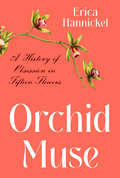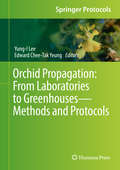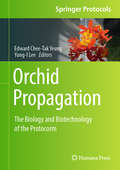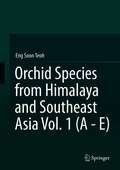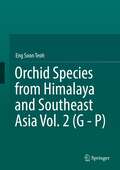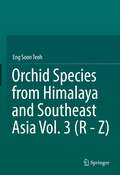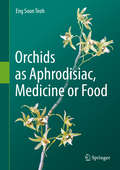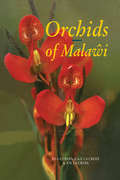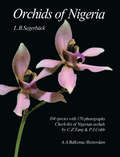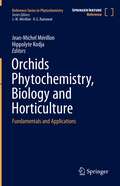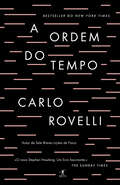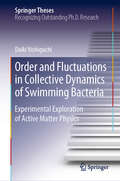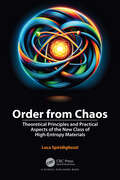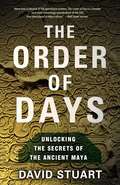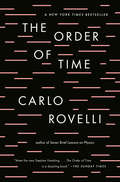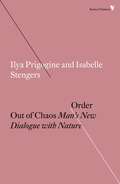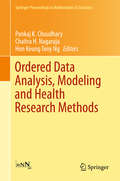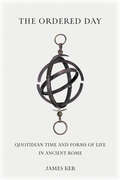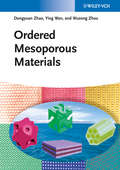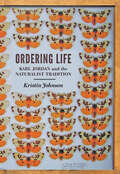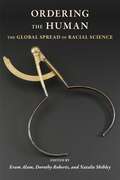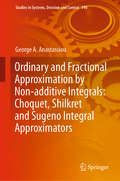- Table View
- List View
The Orchid Genome (Compendium of Plant Genomes)
by Fure-Chyi Chen Shih-Wen ChinThis book provides information on genome complexity and evolution, transcriptome analysis, miRNome, simple sequence repeats, genome relationships, molecular cytogenetics, polyploidy induction and application, flower and embryo development. Orchids account for a great part of the worldwide floriculture trade both as cut flowers and as potted plants and are assessed to comprise around 10% of global fresh cut flower trade. A better understanding of the basic botanical characteristics, flower regulation, molecular cytogenetics, karyotypes and DNA content of important orchids will aid in the efficient development of new cultivars. The book also describes the composition, expression and function of various microRNAs and simple sequence repeats. Information on their involvement in all aspects of plant growth and development will aid functional genomics studies.
Orchid Muse: A History Of Obsession In Fifteen Flowers
by Erica HannickelOne of Literary Hub's Most Anticipated Books of 2022 A kaleidoscopic journey into the world of nature’s most tantalizing flower, and the lives it has inspired. The epitome of floral beauty, orchids have long fostered works of art, tales of adventure, and scientific discovery. Tenacious plant hunters have traversed continents to collect rare specimens; naturalists and shoguns have marveled at orchids’ seductive architecture; royalty and the smart set have adorned themselves with their allure. In Orchid Muse, historian and home grower Erica Hannickel gathers these bold tales of the orchid-smitten throughout history, while providing tips on cultivating the extraordinary flowers she features. Consider Empress Eugenie and Queen Victoria, the two most powerful women in nineteenth-century Europe, who shared a passion for Coelogyne cristata, with its cascading, fragrant white blooms. John Roebling, builder of the Brooklyn Bridge, cultivated thousands of orchids and introduced captivating hybrids. Edmond Albius, an enslaved youth on an island off the coast of Madagascar, was the first person to hand-pollinate Vanilla planifolia, leading to vanilla’s global boom. Artist Frida Kahlo was drawn to the lavender petals of Cattleya gigas and immortalized the flower’s wilting form in a harrowing self-portrait, while more recently Margaret Mee painted the orchids she discovered in the Amazon to advocate for their conservation. The story of orchidomania is one that spans the globe, transporting readers from the glories of the palace gardens of Chinese Empress Cixi to a seedy dime museum in Gilded Age New York’s Tenderloin, from hazardous jungles to the greenhouses and bookshelves of Victorian collectors. Lush and inviting, with radiant full-color illustrations throughout, Orchid Muse is the ultimate celebration of our enduring fascination with these beguiling flowers.
Orchid Propagation: From Laboratories To Greenhouses - Methods And Protocols (Springer Series in Translational Stroke Research)
by Edward Chee-Tak Yeung Yung-I LeeThe orchid family is one of the largest families of flowering plants known for their beauty and economic importance. This work provides information in key areas of research that are important to both scientists and commercial growers alike. The main purposes of this book are to provide key practical areas of research, such as, germination, micropropagation, traditional and current techniques related to plant improvement; document methods that ensure survival of plants from laboratories to greenhouses; promote communication between scientists and growers, so that their combined expertise on these areas will lead to the successful growth of orchids in their natural habitats or commercial greenhouses. This book can serve as reference for laymen with an interest in orchid growing.This book is divided into 5 parts. The first part emphasizes propagation methods using seeds and related techniques that are important to plant conservation and improvement. Successes in asymbiotic and symbiotic seed germination are keys to orchid conservation and their propagation. The second part summarizes micropropagation methods, common media, and newer methods of micropropagation such as the bioreactor culture procedures. The third part focuses on techniques related to the manipulation of explants in an in vitro environment. The fourth part covers cell biological methods and transformation techniques. Since the successes in a laboratory setting do not guarantee plant survival and propagation in greenhouses and in the natural environment, it discusses greenhouse propagation techniques that are essential to the survival of plants generated from a laboratory setting. The fifth part showcases recent successes on orchid propagation by documenting sample publications and how to present orchids in an artistic fashion for one’s enjoyment.
Orchid Propagation: The Biology and Biotechnology of the Protocorm (Springer Protocols Handbooks)
by Yung-I Lee Edward Chee-Tak YeungThis volume provides the first discussion of orchid protcorm and propagation, detailing genome editing research and offers orchid conservation and ecology. Chapters emphasize both the theory and practice of protocorm manipulation, describing protocorm's biology, and a range of related topics useful in studying protocorm. Authoritative and cutting-edge, Orchid Propagation: The Biology and Biotechnology of the Protocorm aims to be a useful practical guide to researches to help further their study in this field.
Orchid Species from Himalaya and Southeast Asia Vol. 1 (A - E)
by Eng Soon TeohA presentation of 491 popular orchid species with 13 varieties and 3 natural hybrids in 51 genera with names beginning with A to E carefully detailed with beautiful photographs and concise descriptions of the plants, their distribution and habitats by a well-known author and photographer. Each genus is assigned a separate chapter. Coverage of the most commonly cultivated Asian species including their varieties and cultivars (e.g. in Bulbophyllum 82 species; Coelogyne 37 species; Dendrobium 210 species) is exhaustive. The orchids are photographed from their best perspective as individual blooms or entire inflorescences. Many species are also shown growing in their natural habitat. Representative hybrids are included to illustrate how some species have contributed to show-worthiness of various genera, their adaptation to a wider climate range, and easy cultivation. This book is a pleasure to view; simultaneously, an easy reference for the identification of orchid species and it provides a guide on how best to grow them. Nowhere else will one find so many popular species beautifully illustrated in a single volume.Volume 1 is the first of a 3 Volume series that will showcase over 900 species plus varieties in 117 genera. A must for everyone fascinated by orchids or simply with a love for nature.
Orchid Species from Himalaya and Southeast Asia Vol. 2 (G - P)
by Eng Soon TeohA presentation of over 700 popular orchid species in 104 genera carefully detailed with beautiful photographs and concise descriptions of plants, their distribution and habitats by a well-known author and photographer. Each genus is assigned a separate chapter. Coverage of the most commonly cultivated Asian species including their varieties and cultivars (e.g. in Bulbophyllum 72 species; Coelogyne 33 species; Dendrobium 161 species; Paphiopedilum 58 species; Phalaenopsis 60 species; Vanda 44 species) is exhaustive. The orchids are photographed from their best perspective, individual blooms and entire inflorescence: additionally, many species are also shown growing in their natural habitat. Representative hybrids are included to illustrate how some species have contributed to show-worthiness of various genera, their adaptation to a wider climate range, and easy cultivation. This book is a pleasure to view; simultaneously, an easy reference for the identification of orchid species and it provides a guide on how best to grow them. Nowhere else will one find so many popular species beautifully illustrated in a single volume.A must for everyone fascinated by orchids or with a love for nature.
Orchid Species from Himalaya and Southeast Asia Vol. 3 (R - Z)
by Eng Soon TeohA presentation of over 700 popular orchid species in 104 genera carefully detailed with beautiful photographs and concise descriptions of plants, their distribution and habitats by a well-known author and photographer. Each genus is assigned a separate chapter. Coverage of the most commonly cultivated Asian species including their varieties and cultivars (e.g. in Bulbophyllum 72 species; Coelogyne 33 species; Dendrobium 161 species; Paphiopedilum 58 species; Phalaenopsis 60 species; Vanda 44 species) is exhaustive. The orchids are photographed from their best perspective, individual blooms and entire inflorescence: additionally, many species are also shown growing in their natural habitat. Representative hybrids are included to illustrate how some species have contributed to show-worthiness of various genera, their adaptation to a wider climate range, and easy cultivation. This book is a pleasure to view; simultaneously, an easy reference for the identification of orchid species and it provides a guide on how best to grow them. Nowhere else will one find so many popular species beautifully illustrated in a single volume.A must for everyone fascinated by orchids or with a love for nature.
Orchids as Aphrodisiac, Medicine or Food
by Eng Soon TeohDid you know that Vanilla was formerly served as aphrodisiac by Cassanova and Madam Pompadour, and Elizabeth I loved its flavor? This is the first book that provides a complete worldwide coverage of orchids being employed as aphrodisiacs, medicine or charms and food. Opening with an in-depth historical account of orchids (orchis Greek testicle), the author describes how the Theory of Signatures influenced ancient herbalists to regard terrestrial orchid tubers as aphrodisiacs. Doctors and apothecaries promoted it during the Renaissance. Usage of orchids in Traditional Chinese Medicine, Indian Ayurvedic Medicine; by Tibetan yogins and Amchi healers for longevity pills, tonics and aphrodisiacs; by Africans to prepare 'health promoting' chikanda or as survival food when lost in the Australian bush are some highlights of the book. Early settlers in America and the East Indies often relied on native remedies and employment of orchids for such needs is described. Also covered are the search for medicinal compounds by scientists, attempts to prove the orchid's efficacy by experiment and the worry of conservationists.
Orchids of Malawi
by Isobyl LaCroix T.M LaCroixThis text covers all of the Malawi orchids, both epiphytic and terrestrial.
Orchids of Nigeria
by L.B. SegerbackThis text includes a description of 104 species with 195 photographs. It also contains a checklist of Nigerian orchids.
Orchids Phytochemistry, Biology and Horticulture: Fundamentals and Applications (Reference Series in Phytochemistry)
by Jean-Michel Mérillon Hippolyte KodjaThis reference work provides an authoritative and comprehensive review of the latest developments in orchids’ biology, biotechnology and phytochemistry, and it also explores the applications of orchids in medicinal chemistry, nutrition and cosmetics industry. Chapters from expert contributors are organised into six sections and cover the entire gamut of orchid research and uses. In this work, readers will learn about topics such as biogeography and diversity of orchids, their biology and environmental factors, their horticulture and phytochemistry, and their use in agri-food, medicinal and perfumery industries. This book will appeal to graduate students, scholars, researchers interested in botany, agriculture, pharmacy, biotechnology and phytochemistry. Industrial scientists and those involved in marketing flowers and phytochemicals, plants and their extracts will also understand the importance of this reference work.
A Ordem do Tempo
by Carlo Rovelli«A física moderna encontrou em Rovelli o seu poeta. Um livro cativante, fascinante, profundamente belo.»John Banville Do autor de Sete Breves lições de física, chega-nos um livro que mudará para sempre a nossa relação com a vida e com o Universo. «O novo Stephen Hawking. Um livro fascinante.»The Sunday Times O que é o tempo e até que ponto o compreendemos? Temos uma existência no tempo ou o tempo existe dentro de nós? O que significa a ideia do «correr» do tempo? Estará o passado realmente fechado e o futuro tão em aberto como julgamos? E o tempo existe, de facto?Numa abordagem luminosa e apaixonante, o físico Carlo Rovelli traz-nos um novo entendimento sobre o maior mistério da humanidade. Um mistério que diz respeito a todos nós, porque o experienciamos a todo o momento. O tempo. Escrito com a vitalidade poética que imprimira anteriormente a Sete breves lições de física, este é o ensaio científico e filosófico que mudará para sempre a nossa relação com a vida e com o Universo, porque para compreender o tempo precisamos de reflectir sobre nós. Combinando arte, filosofia e ciência, Carlo Rovelli transforma esta missão divulgadora sobre o mistério do tempo no maior dos prazeres, na mais bela das histórias. Carlo Rovelli é físico teórico e membro do Instituto Universitário de França e da Academia Internacional de Filosofia e das Ciências. Trabalhou em Itália, Estados Unidos e França. Com vários livros publicados na área, Sete Breves Lições de Física trouxe-lhe a merecida admiração de académicos e leigos, conquistando mais de um milhão de leitores à volta do mundo.
Order and Fluctuations in Collective Dynamics of Swimming Bacteria: Experimental Exploration of Active Matter Physics (Springer Theses)
by Daiki NishiguchiThis thesis focuses on experimental studies on collective motion using swimming bacteria as model active-matter systems. It offers comprehensive reviews of state-of-the-art theories and experiments on collective motion from the viewpoint of nonequilibrium statistical physics. The author presents his experimental studies on two major classes of collective motion that had been well studied theoretically. Firstly, swimming filamentous bacteria in a thin fluid layer are shown to exhibit true, long-range orientational order and anomalously strong giant density fluctuations, which are considered universal and landmark signatures of collective motion by many numerical and theoretical works but have never been observed in real systems. Secondly, chaotic bacterial turbulence in a three-dimensional dense suspension without any long-range order as described in the first half is demonstrated to be capable of achieving antiferromagnetic vortex order by imposing a small number of constraints with appropriate periodicity. The experimental results presented significantly advance our fundamental understanding of order and fluctuations in collective motion of motile elements and their future applications.
Order from Chaos: Theoretical Principles and Practical Aspects of the New Class of High-Entropy Materials
by Luca Spiridigliozzi"Order from Chaos: Theoretical Principles and Practical Aspects of the New Class of High-Entropy Materials" offers a comprehensive exploration of High-Entropy Materials, a novel class of materials characterized by complex compositions and unexpected properties. The book delves into the fundamental principles underlying the formation and stabilization of differently structured High-Entropy Ceramics, presenting a detailed analysis of their main physical and technological properties. Moreover, the book discusses the challenges and future prospects of High-Entropy Ceramics as well as their potential applications in various industrial sectors, making it a useful resource for researchers and engineers in the field of advanced ceramics.
The Order of Days: The Maya World and the Truth About 2012
by David StuartThe world's foremost expert on Maya culture looks at 2012 hysteria and explains the truth about what the Maya meant and what we want to believe.Apocalypse 2012: An Investigation into Civilizations End. The World Cataclysm in 2012. 2012: The return of Quetzalcoatl. According to many of these alarmingly titled books, the ancient Maya not only had a keen insight into the mystical workings of our planet and the cosmos, but they were also able to predict that the world will end in the year 2012.David Stuart, the foremost scholar of the Maya and recipient of numerous awards for his work, takes a hard look at the frenzy over 2012 and offers a fascination (and accurate) trip through Mayan culture and belief. Stuart shows how the idea that the "end of the Mayan calendar," which supposedly heralds the end of our own existence, says far more about our culture than about the ancient Maya. The Order of Days explores how the real intellectual achievement of ancient Maya timekeeping and worldview is far more impressive and remarkable than any of the popular, and often outrageous, claims about this advanced civilization.As someone who has studied the Maya for nearly all of his life and who specializes in reading their ancient texts, Stuart sees the 2012 hubbub as the most recent in a long chain of related ideas about Mesoamericans, the Maya in particular, that depicts them as somehow oddball, not "of this world," or as having some strong mystical link to other realms.Because the year 2012 has no prominent role in anything the ancient Maya ever actually wrote, Stuart takes a wider look at the Maya concepts of time and their underlying philosophy as we can best understand them. The ancient Maya, Stuart contends, were worthy of study and admiration not because they were strange but because they were altogether human, and they developed a compelling vision of time unlike any other civilization before or since.From the Hardcover edition.
The Order of Time
by Carlo Rovelli<P>From the bestselling author of Seven Brief Lessons on Physics, a concise, elegant exploration of time.Why do we remember the past and not the future? What does it mean for time to "flow"? <P>Do we exist in time or does time exist in us? In lyric, accessible prose, Carlo Rovelli invites us to consider questions about the nature of time that continue to puzzle physicists and philosophers alike. <P>For most readers this is unfamiliar terrain. We all experience time, but the more scientists learn about it, the more mysterious it remains. We think of it as uniform and universal, moving steadily from past to future, measured by clocks. <P>Rovelli tears down these assumptions one by one, revealing a strange universe where at the most fundamental level time disappears. He explains how the theory of quantum gravity attempts to understand and give meaning to the resulting extreme landscape of this timeless world. <P>Weaving together ideas from philosophy, science and literature, he suggests that our perception of the flow of time depends on our perspective, better understood starting from the structure of our brain and emotions than from the physical universe. <P>Already a bestseller in Italy, and written with the poetic vitality that made Seven Brief Lessons on Physics so appealing, The Order of Time offers a profoundly intelligent, culturally rich, novel appreciation of the mysteries of time. <P><b>A New York Times Bestseller</b>
Order Out of Chaos
by Ilya Prigogine Isabelle StengersA pioneering book that shows how the two great themes of classic science, order and chaos, are being reconciled in a new and unexpected synthesis.Order Out of Chaos is a sweeping critique of the discordant landscape of modern scientific knowledge. In this landmark book, Nobel Laureate Ilya Prigogine and acclaimed philosopher Isabelle Stengers offer an exciting and accessible account of the philosophical implications of thermodynamics. Prigogine and Stengers bring contradictory philosophies of time and chance into a novel and ambitious synthesis. Since its first publication in France in 1978, this book has sparked debate among physicists, philosophers, literary critics and historians.
Ordered Data Analysis, Modeling and Health Research Methods
by Hon Keung Tony Ng Chaitra H. Nagaraja Pankaj K. ChoudharyThis volume presents an eclectic mix of original research articles in areas covering the analysis of ordered data, stochastic modeling and biostatistics. These areas were featured in a conference held at the University of Texas at Dallas from March 7 to 9, 2014 in honor of Professor H. N. Nagaraja's 60th birthday and his distinguished contributions to statistics. The articles were written by leading experts who were invited to contribute to the volume from among the conference participants. The volume is intended for all researchers with an interest in order statistics, distribution theory, analysis of censored data, stochastic modeling, time series analysis, and statistical methods for the health sciences, including statistical genetics.
The Ordered Day: Quotidian Time and Forms of Life in Ancient Rome (Cultural Histories of the Ancient World)
by James KerTraces how the day has served as a key organizing concept in Roman culture—and beyond.How did ancient Romans keep track of time? What constituted a day in ancient Rome was not the same twenty-four hours we know today. In The Ordered Day, James Ker traces how the day served as a key organizing concept, both in antiquity and in modern receptions of ancient Rome. Romans used the story of how the day emerged as a unit of sociocultural time to give order to their own civic and imperial history. Ancient literary descriptions of people's daily routines articulated distinctive forms of life within the social order. And in the imperial period and beyond, outsiders—such as early Christians in their monastic rules and modern antiquarians in books on daily life—ordered their knowledge of Roman life through reworking the day as a heuristic framework.Scholarly interest in Roman time has recently moved from the larger unit of the year and calendar to smaller units of time, especially in the study of sundials and other timekeeping technologies of the ancient Mediterranean. Through extensive analysis of ancient literary texts and material culture as well as modern daily life handbooks, Ker demonstrates the privileged role that "small time" played, and continues to play, in Roman literary and cultural history. Ker argues that the ordering of the day provided the basis for the organizing of history, society, and modern knowledge about ancient Rome. For readers curious about daily life in ancient Rome as well as for students and scholars of Roman history and Latin literature, The Ordered Day provides an accessible and fascinating account of the makings of the Roman day and its relationship to modern time structures.
Ordered Mesoporous Materials
by Wuzong Zhou Dongyuan Zhao Ying WanMesoporous materials are a class of molecules with a large and uniform pore size, highly regular nanopores, and a large surface area. This book is devoted to all aspects and types of these materials and describes, in an in-depth and systematic manner, the step-by-step synthesis and its mechanism, as well as the characterization, morphology control, hybridization, and applications, of mesoporous molecular sieves. In so doing, it covers silicates, metal-doped silicates, nonsilicates, and organic-inorganic hybrids.Although the emphasis is on synthesis, the expert authors also discuss characterization and applications, ranging from catalysis and biochemistry to optics and the use of these materials as templates for nanomaterial synthesis. Both the fundamentals and the latest research results are covered, ensuring that this monograph serves as a reference for researchers in and newcomers to the field.
Ordering Life: Karl Jordan and the Naturalist Tradition
by Kristin JohnsonExamines the life of prolific taxonomist Karl Jordan in the context of contemporary events and societal trends.For centuries naturalists have endeavored to name, order, and explain biological diversity. Karl Jordan (1861–1959) dedicated his long life to this effort, describing thousands of new species in the process. Ordering Life explores the career of this prominent figure as he worked to ensure a continued role for natural history museums and the field of taxonomy in the rapidly changing world of twentieth-century science. Jordan made an effort to both practice good taxonomy and secure status and patronage in a world that would soon be transformed by wars and economic and political upheaval. Kristin Johnson traces his response to these changes and shows that creating scientific knowledge about the natural world depends on much more than just good method or robust theory. The broader social context in which scientists work is just as important to the project of naming, describing, classifying, and, ultimately, explaining life.
Ordering Life: Karl Jordan and the Naturalist Tradition
by Kristin JohnsonThis biography of the eminent naturalist explores his life and pioneering work through the rapidly changing world of 19th and 20th century science.For centuries naturalists have endeavored to name, order, and explain biological diversity. Born in 1861, Karl Jordan dedicated his long life to this project, describing thousands of new species in the process. Ordering Life celebrates Jordan’s distinguished career as an entomologist and chronicles his efforts to secure a place for natural history museums and the field of taxonomy.In the face of a changing scientific landscape, Jordan was determined to practice good taxonomy while also pursuing status and patronage—an effort that included close collaboration with the Rothschilds. Biographer Kristin Johnson traces the evolution of Jordan’s work through wars, economic fluctuation, and political upheaval, demonstrating that the broader social context is an essential aspect of naming, describing, classifying, and, ultimately, explaining life.
Ordering the Human: The Global Spread of Racial Science (Race, Inequality, and Health #15)
by Eram Alam, Dorothy Roberts, and Natalie ShibleyModern science and ideas of race have long been entangled, sharing notions of order, classification, and hierarchy. Ordering the Human presents cutting-edge interdisciplinary scholarship that examines the racialization of science in various global contexts, illuminating how racial logics have been deployed to classify, marginalize, and oppress.These wide-ranging essays—written by experts in genetics, forensics, public health, history, sociology, and anthropology—investigate the influence of racial concepts in scientific knowledge production across regions and eras. Chapters excavate the mechanisms by which racialized science serves projects of power and domination, and they explore different forms of resistance. Topics range from skull collecting by eighteenth-century German and Dutch scientists to the use of biology to reinforce notions of purity in present-day South Korea and Brazil. The authors investigate the colonial legacies of the pathologization of weight for the Maori people, the scientific presumption of coronary artery disease risk among South Asians, and the role of racial categories in COVID-19 statistics and responses, among many other cases. Tracing the pernicious consequences of the racialization of science, Ordering the Human shines a light on how the naturalization of racial categories continues to shape health and inequality today.
Ordinary and Fractional Approximation by Non-additive Integrals: Choquet, Shilkret and Sugeno Integral Approximators (Studies in Systems, Decision and Control #190)
by George A. AnastassiouOrdinary and fractional approximations by non-additive integrals, especially by integral approximators of Choquet, Silkret and Sugeno types, are a new trend in approximation theory. These integrals are only subadditive and only the first two are positive linear, and they produce very fast and flexible approximations based on limited data. The author presents both the univariate and multivariate cases. The involved set functions are much weaker forms of the Lebesgue measure and they were conceived to fulfill the needs of economic theory and other applied sciences. The approaches presented here are original, and all chapters are self-contained and can be read independently. Moreover, the book’s findings are sure to find application in many areas of pure and applied mathematics, especially in approximation theory, numerical analysis and mathematical economics (both ordinary and fractional). Accordingly, it offers a unique resource for researchers, graduate students, and for coursework in the above-mentioned fields, and belongs in all science and engineering libraries.
Ordinary Differential Equations with Applications (Texts in Applied Mathematics #34)
by Carmen ChiconeThis book, developed during 20 years of the author teaching differential equations courses at his home university, is designed to serve as a text for a graduate level course focused on the central theory of the subject with attention paid to applications and connections to other advanced topics in mathematics. Core theory includes local existence and uniqueness, the phase plane, Poincaré-Bendixson theory, Lyapunov and linearized stability, linear systems, Floquet theory, the Grobman–Hartman theorem, persistence of rest points and periodic orbits, the stable and center manifold theorems, and bifurcation theory. This edition includes expanded treatment of deterministic chaos, perturbation theory for periodic solutions, boundary value problems, optimization, and a wide range of their applications. In addition, it contains a formulation and new proof of a theorem on instability of rest points in the presence of an eigenvalue with positive real part, and new proofs of differential inequalities and Lyapunov’s center theorem. New sections present discussions of global bifurcation, the Crandall–Rabinowitz theorem, and Alekseev’s formula. Of particular note is a new chapter on basic control theory, a discussion of optimal control, and a proof of a useful special case of the maximum principle. A key feature of earlier editions, a wide selection of original exercises, is respected in this edition with the inclusion of a wealth of new exercises. Reviews of the first edition:“As an applied mathematics text on linear and nonlinear equations, the book by Chicone is written with stimulating enthusiasm. It will certainly appeal to many students and researchers.”—F. Verhulst, SIAM Review “The author writes lucidly and in an engaging conversational style. His book is wide-ranging in its subject matter, thorough in its presentation, and written at a generally high level of generality, detail, and rigor.”—D. S. Shafer, Mathematical Reviews

